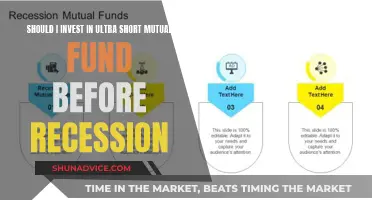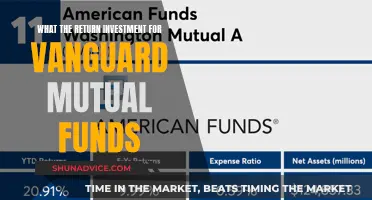
As you approach retirement, it's important to consider how to protect your nest egg and ensure your financial security. While it may be tempting to make drastic changes to your investments, experts advise against this, as it could decrease your net worth in the long run. Instead, focus on the aspects you can control, such as your spending habits, work plans, and management of other assets.
One way to generate retirement income is through mutual funds and exchange-traded funds (ETFs) that are focused on generating income. These funds can provide a steady stream of interest and dividend income, while also seeking capital growth over the long term. Additionally, you can explore other investment options such as bonds, annuities, and income-producing equities to supplement your retirement income.
It's crucial to understand the risks and potential upsides of different investment options and to seek guidance from a financial professional to determine the most suitable strategies for your circumstances.
| Characteristics | Values |
|---|---|
| Investment Options | Income-producing equities, annuities, bonds, mutual funds, exchange-traded funds (ETFs), savings accounts, certificates of deposit, dividend-paying blue-chip stocks, real estate investment trusts, high-yield savings accounts, stable value funds, money market mutual funds, municipal bonds, index funds, and more. |
| Benefits | Steady income, tax advantages, diversification, capital preservation, growth potential, reduced risk, and more. |
| Risks | Inflation, default, market volatility, liquidity issues, tax penalties, credit risk, interest rate changes, and more. |
| Considerations | Risk tolerance, time horizon, financial goals, market conditions, fees, and more. |
What You'll Learn

Dividend-paying blue-chip stocks
When considering dividend-paying blue-chip stocks for your retirement portfolio, look for companies that have a history of paying steadily rising dividends and are likely to continue doing so over the long term. Some blue-chip companies, known as Dividend Aristocrats, have increased their dividends consistently for at least 25 consecutive years and are part of the S&P 500 index. Others, known as Dividend Kings, have increased their dividends for 50 years or more.
- Apple (AAPL): Apple has provided immense returns over the past two decades and is now one of the biggest and most profitable companies in the world. The success of the iPhone, which generates more than half of Apple's sales, along with its powerful brand, makes Apple a reliable investment choice. Apple has also raised its dividend every year since 2013.
- Mastercard (MA): Mastercard, a well-known global name in electronic payments, has competitive advantages that enable it to maintain its dominant position in the market. The company has increased its dividend payout dramatically over the years, making it an attractive choice for dividend investors.
- Broadcom (AVGO): Broadcom is a semiconductor company that designs parts for a wide range of items, from smartphones to data centre hardware. With its focus on research and development and recent expansion into software, Broadcom is one of the most profitable names in the semiconductor industry. The company has a strong track record of increasing its dividend payout.
- Nike (NKE): Nike, a well-known blue-chip stock, has been a dominant brand in athletic footwear and apparel for decades. With its global recognition and pricing power, Nike has consistently grown its earnings, enabling it to raise its dividend payout annually for 22 consecutive years.
- NextEra Energy (NEE): NextEra Energy is a unique utility company that produces and sells renewable energy to utility companies in other markets. As one of the largest utility companies in the US and a leading producer of renewable energy globally, NextEra benefits from steady electricity demand and the growing demand for renewable energy sources. The company has planned to increase its dividend payout by roughly 10% annually through at least 2026.
When investing in dividend-paying blue-chip stocks, it is important to conduct thorough research and consider factors such as dividend safety, balance sheet strength, return on invested capital, and the company's economic moat. Additionally, it is essential to diversify your portfolio by investing in a range of companies from different industries to minimise risk.
Bond Index Funds: When to Invest and Why
You may want to see also

Municipal bonds
Muni bonds are attractive to retirees for several reasons. Firstly, they offer stable and predictable returns with lower risk compared to stocks. This makes them ideal for preserving capital and generating income during retirement. Secondly, the interest received from muni bonds is often exempt from federal income taxes, and sometimes from state and local taxes as well, especially if the bonds are purchased in the state where the investor lives. This tax advantage can result in higher after-tax returns compared to other investments.
However, it is important to consider some potential drawbacks of muni bonds. The interest rate on muni bonds is generally lower than that of corporate bonds, so investors need to carefully evaluate the real return. Additionally, the interest from muni bonds can be counted as income when calculating the taxable amount of Social Security income, potentially increasing the tax liability. Moreover, there may be tax implications related to the alternative minimum tax and the de minimus tax. Lastly, muni bonds are subject to interest rate risk, which means that if interest rates rise during the term of the bond, investors may be stuck with a poor-performing investment that loses value.
Overall, municipal bonds can be a good addition to a retirement portfolio, especially for those seeking stable and tax-advantaged income. However, it is important to carefully consider the potential risks and tax implications before investing.
Emergency Fund Strategies: Philippines Investment Options
You may want to see also

High-yield savings accounts
These accounts are ideal for those who want their savings to grow but don't want to take on the risks associated with investing. They are also a good option for those who want easy access to their money, as there are typically no restrictions on withdrawals. Additionally, high-yield savings accounts usually have low or no service charges and no minimum balance requirements.
- UFB Portfolio Savings: This account offers a competitive APY and has no maintenance or service fees. It also doesn't require a minimum deposit.
- Capital One 360 Performance Savings: This account has no fees or minimum deposit requirements and yields that beat the national average by a wide margin.
- CIT Bank Platinum Savings: This account offers a competitive savings rate and has no monthly service fees. However, to earn the highest APY, you need to maintain a balance of $5,000 or more.
- SoFi Checking and Savings: This account offers a welcome bonus of up to $300 when you set up direct deposits. It also has no account or overdraft fees and provides early access to your paycheck.
- Ally Bank Savings Account: This account offers savings boosters and buckets, zero monthly fees or minimum balance requirements, and 24/7 customer support.
Mutual Fund Investment: Strategies, Risks, and Rewards
You may want to see also

Certificates of deposit
CDs are a safer and more conservative investment than stocks and bonds, but they offer a lower opportunity for growth. They are insured by the Federal Deposit Insurance Corporation (FDIC) or the National Credit Union Administration (NCUA), which means that up to $250,000 of your funds are protected in the rare event that the institution fails.
CDs are a stable, short-term cash investment, comparable to a traditional savings account or money market account. They can be a low-risk asset in your investment portfolio, particularly if you choose one of the best CDs that pay higher annual percentage yields (APY).
There are several types of CDs:
- Bump-up CDs, which allow investors to take advantage of rising interest rates by increasing the rate of interest paid by the CD.
- IRA CDs, which are nested within an individual retirement account (IRA) and can be a stable, lower-risk source of income for those nearing retirement age.
- Jumbo CDs, which typically require a minimum investment of $100,000 and offer a higher interest rate.
- No-penalty CDs, which don't charge a fee for early withdrawal but may have fewer term options and lower interest rates.
When deciding whether to invest in a CD, consider the following:
- Your financial goals, both short-term and long-term.
- How much money you have to deposit and the minimum deposit requirements of different CDs.
- How long you can leave your money in the CD without touching it, which will help you determine the right term.
- The interest rates offered for your term and minimum deposit.
- The type of CD that best meets your needs and goals.
CDs can be a good option if you want a conservative investment or if you have cash that you won't need for a few years. They offer a guaranteed, predictable rate of return, but it's important to be aware of the risks and limitations, such as early withdrawal penalties and the potential for lower returns compared to riskier investments.
Maharlika Investment Fund: A Sovereign Wealth Fund for the Philippines
You may want to see also

Annuities
There are several types of annuities:
- Fixed annuities, sometimes referred to as fixed deferred annuities, provide guaranteed asset growth at a fixed rate for a specific time period.
- Variable annuities allow you to get a payout that may grow over time by investing your money in various mutual funds or other funds that hold stocks, bonds and other assets.
- Indexed annuities, including fixed indexed annuities (FIAs) and registered index-linked annuities (RILAs), provide an opportunity for growth tied to the positive performance of a market index, as well as a level of protection when the market index performance is negative.
- Income annuities, including single premium immediate annuities and deferred income annuities, provide guaranteed lifetime income or income for a specific period of time that you choose.
When considering an annuity, it is important to carefully research the different types and choose the one that best fits your financial goals and risk tolerance. Annuities can have high fees and charges, so it is important to understand all the costs involved before purchasing one. Additionally, annuities often have a long commitment period, and early withdrawals may be subject to surrender charges and penalties.
Closed-End Investment Funds: Where and How to Trade
You may want to see also
Frequently asked questions
Safe investment options for retirees include dividend-paying blue-chip stocks, real estate investment trusts, high-yield savings accounts, and certificates of deposit.
Low-risk investment options include U.S. Treasury bonds, Treasury Inflation-Protected Securities (TIPS), U.S. Savings Bonds, and municipal bonds.
To protect retirement savings, consider working longer, cutting back on spending, taking on short-term debt, and thinking through long-term strategies such as home equity loans or reverse mortgages.
Common investment options to generate retirement income include income annuities, diversified bond portfolios, a total return investment approach, and income-producing equities.







